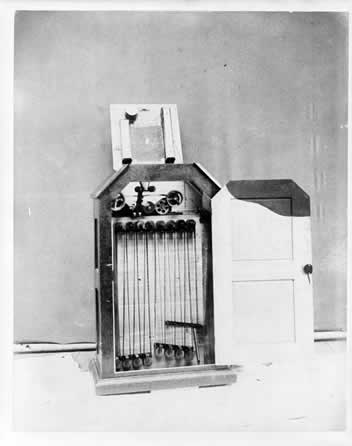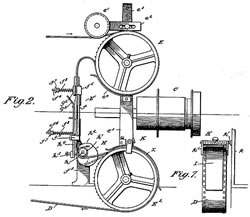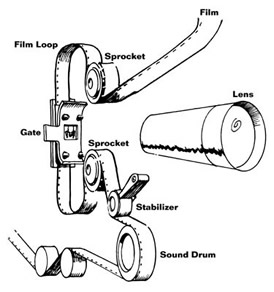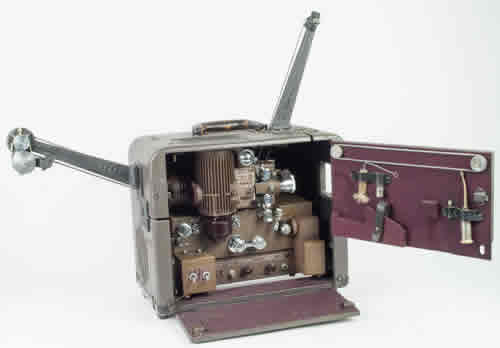Kinetoscope
 Originally,
Edison conceived of movies as an accompaniment to phonographs.
However, that proved to be too difficult a technical problem. Movies would be mostly silent until 1927-1928.
Originally,
Edison conceived of movies as an accompaniment to phonographs.
However, that proved to be too difficult a technical problem. Movies would be mostly silent until 1927-1928.
However, by the early 1890s, Edison produced an individual viewing device that could show a loop of film about 50 feet long.
Next: parlor

The flaw in Edison's design: Ok, here's some pretty heavy film nerd stuff. As you know, a movie is just a series of still photographs. That has important implications for the way film moves through a camera and projector. It can't be a smooth motion. The film must briefly stop in front of the lens to take or show the picture. So, the motion is stop, advance about an inch and a half, stop advance about an inch and a half, etc. In Edison's original Kinetograph and scope, the film fed directly from the reel to the shutter and lens, to the take up reel. That meant that this jerking motion was absorbed by the film itself and that fact limited the length of the film that could be made. Film was fairly heavy and fairly fragile. If there was more than about 30 seconds of film on the reel before the lens when the film jerked forward, it would rip.
This was a particular problem because Otway and Gray Latham, who were very earlier distributers of Edison films, wanted to film prize fights. These were made up of one minute long rounds. The idea was that if film length could be extended to one minute, then the entire fight could be watched on a series of machines. First they went to Edison and got him and Dickson to make a mega-Kinetograph and scope combo that could hold 150 feet of film. But they were not satisfied with this because they wanted first, to be able to show a whole fight without changing machines, and second, believed there would be more money and a bigger audience for the fights if they were projected. Edison wasn't interested because he still saw movies as a fad and still believed his goal was to sell as many machines as fast as possible. However, W. K. L. Dickson, who, you'll remember had actually made the Kinetograph, was also fed up with Edison. Dickson secretly agreed to help the Lathams and he introduced them to another Edison employee, Eugene Lauste.
 The Lathams formed their own company called Lambda, and hired Lauste as their engineer. Together they created a camera and projection system called the eidoloscope. The critical characteristic of the eidoloscope was the "Latham Loop." The idea was simple but ingenious and you can see it diagrammed to the left. The first diagram is from the actual patent and is pretty confusing. The second one shows much later innovations but lets us better understand what was going on. So, look at the second. You'll see sprocket wheels before and after the lens. These wheels moved continuously, as did the reels. A second mechanism behind the gate moved the film in the stop and start pattern essential to take or show movies. The result was that the jerking motion of the film was absorbed by the film loops before and after the lens, taking pressure off the film reels and greatly reducing the possibility of the film breaking. The original eidoloscopes didn't have the sprockets or the sound drum. I'm not sure when the sprockets first appeared but sound only became available in the 1930s.
The Lathams formed their own company called Lambda, and hired Lauste as their engineer. Together they created a camera and projection system called the eidoloscope. The critical characteristic of the eidoloscope was the "Latham Loop." The idea was simple but ingenious and you can see it diagrammed to the left. The first diagram is from the actual patent and is pretty confusing. The second one shows much later innovations but lets us better understand what was going on. So, look at the second. You'll see sprocket wheels before and after the lens. These wheels moved continuously, as did the reels. A second mechanism behind the gate moved the film in the stop and start pattern essential to take or show movies. The result was that the jerking motion of the film was absorbed by the film loops before and after the lens, taking pressure off the film reels and greatly reducing the possibility of the film breaking. The original eidoloscopes didn't have the sprockets or the sound drum. I'm not sure when the sprockets first appeared but sound only became available in the 1930s.
 The Lambda company didn't last long, only a year or so. And they didn't make good films. However, it was this innovation that made movies longer than a minute or so possible. Further, it turned out to be one of the things that prevented Edison from monopolizing the movies. Dickson split from Edison shortly after the incident with the Lathams. He went on to form the American Mutoscope and Biograph company, later famously known as Biograph. And, the Lathams sold him the patent for the loop. Because of this, Edison was unable to block Biograph from making movies.
The Lambda company didn't last long, only a year or so. And they didn't make good films. However, it was this innovation that made movies longer than a minute or so possible. Further, it turned out to be one of the things that prevented Edison from monopolizing the movies. Dickson split from Edison shortly after the incident with the Lathams. He went on to form the American Mutoscope and Biograph company, later famously known as Biograph. And, the Lathams sold him the patent for the loop. Because of this, Edison was unable to block Biograph from making movies.
And one more picture for you. the bottom picture is a mid 20th century Bell and Howell Filmosound projector. These were still very common in classrooms in my childhood. They were noisy and broke constantly. But, if you look carefully you can see how the film flowed through them.

 Originally,
Edison conceived of movies as an accompaniment to phonographs.
However, that proved to be too difficult a technical problem. Movies would be mostly silent until 1927-1928.
Originally,
Edison conceived of movies as an accompaniment to phonographs.
However, that proved to be too difficult a technical problem. Movies would be mostly silent until 1927-1928.
 The Lathams formed their own company called Lambda, and hired Lauste as their engineer. Together they created a camera and projection system called the eidoloscope. The critical characteristic of the eidoloscope was the "Latham Loop." The idea was simple but ingenious and you can see it diagrammed to the left. The first diagram is from the actual patent and is pretty confusing. The second one shows much later innovations but lets us better understand what was going on. So, look at the second. You'll see sprocket wheels before and after the lens. These wheels moved continuously, as did the reels. A second mechanism behind the gate moved the film in the stop and start pattern essential to take or show movies. The result was that the jerking motion of the film was absorbed by the film loops before and after the lens, taking pressure off the film reels and greatly reducing the possibility of the film breaking. The original eidoloscopes didn't have the sprockets or the sound drum. I'm not sure when the sprockets first appeared but sound only became available in the 1930s.
The Lathams formed their own company called Lambda, and hired Lauste as their engineer. Together they created a camera and projection system called the eidoloscope. The critical characteristic of the eidoloscope was the "Latham Loop." The idea was simple but ingenious and you can see it diagrammed to the left. The first diagram is from the actual patent and is pretty confusing. The second one shows much later innovations but lets us better understand what was going on. So, look at the second. You'll see sprocket wheels before and after the lens. These wheels moved continuously, as did the reels. A second mechanism behind the gate moved the film in the stop and start pattern essential to take or show movies. The result was that the jerking motion of the film was absorbed by the film loops before and after the lens, taking pressure off the film reels and greatly reducing the possibility of the film breaking. The original eidoloscopes didn't have the sprockets or the sound drum. I'm not sure when the sprockets first appeared but sound only became available in the 1930s.  The Lambda company didn't last long, only a year or so. And they didn't make good films. However, it was this innovation that made movies longer than a minute or so possible. Further, it turned out to be one of the things that prevented Edison from monopolizing the movies. Dickson split from Edison shortly after the incident with the Lathams. He went on to form the American Mutoscope and Biograph company, later famously known as Biograph. And, the Lathams sold him the patent for the loop. Because of this, Edison was unable to block Biograph from making movies.
The Lambda company didn't last long, only a year or so. And they didn't make good films. However, it was this innovation that made movies longer than a minute or so possible. Further, it turned out to be one of the things that prevented Edison from monopolizing the movies. Dickson split from Edison shortly after the incident with the Lathams. He went on to form the American Mutoscope and Biograph company, later famously known as Biograph. And, the Lathams sold him the patent for the loop. Because of this, Edison was unable to block Biograph from making movies.